Lonicera japonica Thunb profile
Written by Maggie
Nov 18 2020
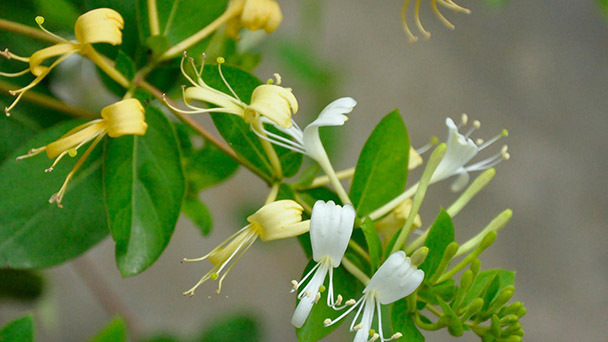
Lonicera japonica Thunb has been known as a good medicine for clearing away heat and detoxification since ancient times. It is sweet and fragrant in nature, clears away heat and does not hurt the stomach.
Lonicera japonica Thunb blooms in March, with five blooms, slightly fragrant, with reddish pedicles. The color of the flower is white at first opening, and yellow after one or two days, hence the name Lonicera japonica Thunb.
Lonicera japonica Thunb picture
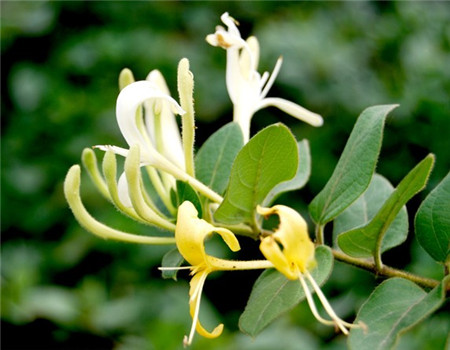
Morphological characteristics of Lonicera japonica Thunb
Lonicera japonica Thunb honeysuckle is a perennial semi-evergreen twining and stolon shrub. The branchlets are slender and hollow, and the vines are brown to russet. The ovoid leaves are opposite, and the branches and leaves are densely pilose and glandular hairs. Flowering in summer, bracts are leaf-shaped, lip-shaped flowers have a light fragrance, and there are pilose and glandular hairs on the outside. The stamens and styles extend out of the corolla. The flowers are born in pairs in the leaf axils. Spherical berries, black when ripe.
The young branches of lonicera japonica thunb are clean reddish brown, densely covered with yellowish brown, spreading hard straight rough hair, glandular hair and pubescent hair, often glabrous underneath. The leaves are papery, ovate to oblong-ovate, sometimes ovate-lanceolate, sparsely ovate or obovate, rarely with 1 to several obtuse, 3 to 5 cm long, tip or acuminate, few obtuse, round or slightly concave, round or nearly heart-shaped at the base, with rough fringed hairs, dark green on the top and light green on the bottom. The upper leaves of the branchlets are usually densely covered with short rough hairs on both sides, and the lower leaves are often smooth and glabrous with a few below Blue-gray; petiole 4-8 mm long, densely pubescent.
The total pedicel of Lonicera japonica Thunb is usually solitary in the upper leaf axil of the branch, equal to or slightly shorter than the petiole, and the lower part is as long as 2 to 4 cm, densely pubescent, and mixed with glandular hairs. Bracts are large, leaf-shaped, oval to elliptic, 2 to 3 cm long, pubescent or sometimes nearly glabrous on both sides; bracteoles are round or truncated at the tip, about 1 mm long, 1/2 to 4/ of the calyx tube 5. There are short shaggy and glandular hairs; the calyx tube is about 2 mm long, glabrous, and the calyx teeth are ovate or long triangular, with pointed tips and long hairs, with dense hairs on the outside and edges; the corolla is white, sometimes facing the sun at the base. The face is reddish, then turns yellow, long (2~) 3~4.5 (~6) cm, lip-shaped. The tube is slightly longer than the lip, rarely nearly equal in length, and the outer part is slightly undeveloped or semi-developed rough hair and long glandular hairs. The top of the upper lip lobes is obtuse, and the lower lip is banded and recurved; the stamens and styles are higher than the corolla.
The flower buds are rod-shaped, thick at the top and thin at the bottom. The outside is yellowish white or light green, densely pubescent. The calyx is small, yellow-green, with 5-lobed apex, and hairy lobes. The open flowers are tubular, apex two-lipped, 5 stamens, attached to the tube wall, yellow, 1 pistil, ovary glabrous. Fresh scent, light taste, slightly bitter. The flower buds are not open, the color is yellow-white or green-white, and there is no branch or leaf impurities.
The fruit of Lonicera japonica Thunb is round, 6-7 mm in diameter, blue-black when ripe, shiny; seeds oval or elliptical, brown, about 3 mm long, with a raised ridge in the middle and shallow horizontal sides on both sides. Flowering period is from April to June (also often blooming in autumn), and fruit ripening period is from October to November.
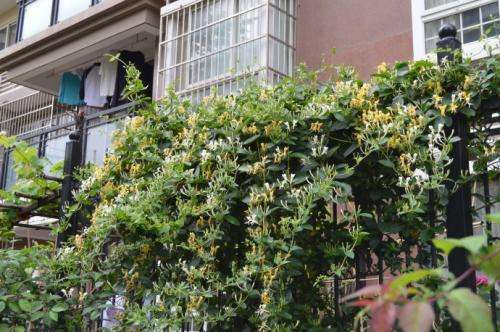
Growth habits of Lonicera japonica Thunb
Lonicera japonica Thunb is highly adaptable. It is sun-loving, shade-tolerant, cold-tolerant, and also resistant to drought and moisture. It does not have strict requirements on the soil, but grows best on moist, fertile and deep sandy soil. It grows best in spring and summer. The root system is dense and well-developed, with strong sprouting, and the vines can take root when they hit the ground.It likes the sun and a mild, humid environment, strong vitality, wide adaptability, cold and drought tolerant, poor growth in shade. Born in hillside shrubs or sparse forests, rock piles, mountain foot roads and village fences, the highest altitude is 1500 meters.
Lonicera japonica Thunb production area
It is distributed in all provinces of China. North Korea and Japan are also distributed. It is a weed that is difficult to remove in North America. The planting areas of Lonicera japonica Thunb are mainly concentrated in Shandong, Shaanxi, Henan, Hebei, Hubei, Jiangxi, Guangdong and other places.
Among them, Pingyi County, Linyi City, Shandong Province is the main producing area of Lonicera japonica Thunb, with the largest planting area, most of the wild varieties, and a long history of about 500,000 acre. Lonicera japonica Thunb is mostly wild in relatively humid areas, such as the banks of streams, moist hillside shrubs, and open forests.
Secondly, Lonicera japonica Thunb has a planting history of more than 1,500 years.
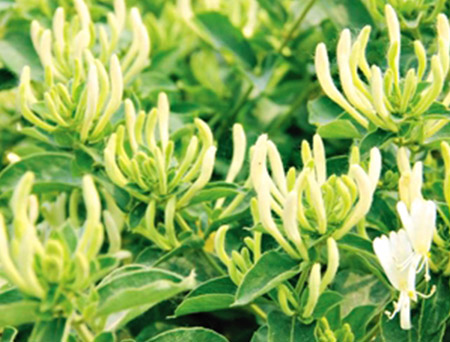
Lonicera japonica Thunb main value
Ornamental value
Because Lonicera japonica Thunb has stronger creeping growth ability than climbing growth ability, it is more suitable for ground cultivation under the forest, forest edge, north side of buildings, etc.; it can also be used as a green wall; it can also be used to make flowers Corridors, flower stands, flower fences, style columns, winding rockery, etc. The advantage is that the vine growth is large and the management is extensive. The disadvantage is that the vine and the vine are entangled, and the ground coverage is uneven, which makes people feel chaotic.
Economic Value
Lonicera japonica Thunb has a wide range of medicinal value and health care applications, which brings unlimited business opportunities to businesses. The Lonicera japonica Thunb tea developed by the Nanjing Wild Plant Research Institute of the Ministry of Commerce using modern science and technology is popular in Hong Kong, Singapore and the United States. The medical raw material "chlorogenic acid" extracted from Lonicera japonica Thunb sells for more than 1,000 yuan per kilogram, and it is still in demand in domestic and foreign markets. Lonicera japonica Thunb can also be exported directly without processing and dried into a dry product to earn foreign exchange. China’s annual export of Lonicera japonica Thunb reaches tens of millions of US dollars.
Medicinal value
Lonicera japonica Thunb is cold in nature, sweet in taste, and enters the lungs, heart, and stomach meridians. It has the effects of clearing heat and detoxification, anti-inflammatory, tonic and remedial wind. It is mainly used to treat fullness, febrile disease and fever, febrile ulcers and tumors. Lonicera japonica Thunb is good for dizziness, dizziness, dry mouth, thirst, hyperhidrosis, enteritis, bacillary dysentery, measles, pneumonia, Japanese encephalitis, meningitis, acute mastitis, sepsis, appendicitis, skin infections, carbuncle furuncle, erysipelas, parotid glands Inflammation, purulent tonsillitis and other diseases have a certain effect.
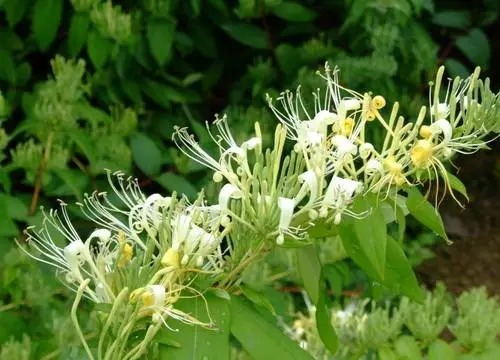
Latest Updated
- Benefits of Bugleweed - 7 Science-backed Health Benefits
- Bugleweed Dangers & Side Effects - Is It Poisonous?
- How to Plant Evergreen Trees - What You Should Know
- When to Plant Evergreens - Grow Guide for Evergreen Trees
- 12 Wonderful Evergreen Shrubs for Your Garden
- 12 Popular Evergreen Plants with Pictures for Beginners
- When And How To Prune A Lilac Bush Like a Pro
- How to Grow & Care for Lilac Vine (Hardenbergia Violacea)
- Japanese Lilac Tree (Syringa Reticulata) Care & Propagation Guide
- Shumard Oak Pros and Cons - What to Know
Popular Articles
- Winter maintenance of Antirrhinum Majus
- How to Grow Terminalia Mantaly Tree
- How to Grow and Care for Crossostephium Chinense
- How to grow Antirrhinum Majus in spring
- Peristeria Elata (Dove Orchid) Profile: Info & Care Guide
- Underwatered Snake Plant (Sansevieria Trifasciata) - Signs And How To Fix
- How to Care for Brazilian Jasmine Plant (Mandevilla Sanderi)
- How to Grow & Care for Graptopetalum Purple Delight in Summer
- Rosa Chinensis (China Rose): Plant Growing & Care Tips
- How to Care for Baby Sun Rose (Aptenia Cordifolia)